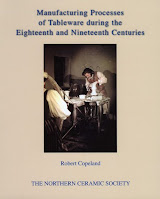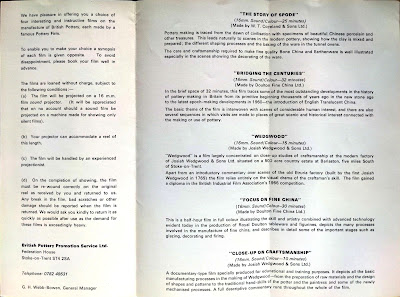A selection of books to help you find out more about the Potteries and its industry
Bottle Ovens and the Story of the Final Firing
Terry and Pam Woolliscroft
The only full account of the last time a bottle oven was fired in The Potteries
In 1978 Gladstone Pottery Museum in Stoke-on-Trent had the audacious idea of firing a potters' bottle oven, with coal, for the very last time. This traditional way of firing pottery had ended in the early 1960s with the introduction of the Clean Air Act. Before all the knowledge and skills of firing a bottle oven were consigned to history the museum embarked on a project which proved to be an enormous undertaking, massively complex and tremendously daunting. This book, published in the 40th anniversary year, tells the story of The Last Bottle Oven Firing.
- Part 1 answers the question 'What is a bottle oven?'
- Part 2 details the entire 1978 final firing with contemporary reports and previously unseen images and a full programme of events.
- Part 3 is a bottle oven dictionary explaining some of the unusual words specific to bottle ovens and the pottery industry.
This book, written by two of the organisers of the Last Bottle Oven Firing in 1978, tells the full story of the final firing. The details are drawn from contemporary audio and film recordings, photos taken by Gladstone volunteers and professionals, committee meeting minutes, surviving notebooks, the event log book, media reports, management reports and remarkable recollections of some of the 72 volunteers involved.
The book was conceived, planned, researched, written, designed, printed, published and distributed entirely in The Potteries of Stoke-on-Trent. Produced with the generous support of the Friends of The Potteries Museum and Art Gallery
£12.99 from Gladstone Pottery Museum shop
Mail Order by phone with credit card +44 (0) 1782 237777
"...wonderful book! ...superbly detailed and presented
- the copious illustrations and photographs are terrific." Ray Johnson MBE
"Love this book's mixture of information, narrative, memories, snapshots,technical diagrams and the glossary of Stoke words." Val Bott MBE
"…incredibly interesting, informative and very well illustrated. I can recommend it to anyone who is interested in the history behind the pottery industry." Brian Milner
More about the author and his websites here > https://linktr.ee/TerryWoolliscroft
- the copious illustrations and photographs are terrific." Ray Johnson MBE
"Love this book's mixture of information, narrative, memories, snapshots,technical diagrams and the glossary of Stoke words." Val Bott MBE
"…incredibly interesting, informative and very well illustrated. I can recommend it to anyone who is interested in the history behind the pottery industry." Brian Milner
More about the author and his websites here > https://linktr.ee/TerryWoolliscroft
Bottle Ovens
by Pam Woolliscroft
Published in 1977 when Pam was the first curator of the Gladstone Pottery Museum, Longton, Stoke-on-Trent, England. Gladstone Pottery Museum.
OUT OF PRINT 2018 - Superseded by Bottle Ovens and the Story of the Final Firing by Terry Woolliscroft and Pam Woolliscroft (see above)
Manufacturing Processes of Tableware
OUT OF PRINT 2018 - Superseded by Bottle Ovens and the Story of the Final Firing by Terry Woolliscroft and Pam Woolliscroft (see above)
Manufacturing Processes of Tableware
during the 18th and 19th Centuries
by Robert Copeland
Northern Ceramic Society, 2009, ISBN: 978-0-9563159-0-8
Dictionary of Ceramics
A. E. Dodd
George Newnes Ltd., 1967
Art and History of the Potting Business
William Evans
Ceramic Faults and their Remedies
Harry Fraser
A&C Black, 2005
Pottery Ovens, Fuels, and Firing
Stanley R. Hind
British Pottery Manufacturers Federation
1937
Potbank
Mervyn Jones
Secker and Warburg, 1961
Notes on the Manufacture of Earthenware
E.A.Sandeman
1921
An Encyclopaedia of the Ceramic industries
3 volumes
Alfred B Searle
Ernest Benn London, 1929/1930
Dialect Words and Phrases used in the Staffordshire Potteries
Compiled by Robert Nicholls,
Crewe, 1934
More details here>
" This booklet is primarily for the benefit of those of you who are about to take one of the most important steps in your life ... "
" If you choose the right job and the one you like, you have made a good start in life. If you choose an industry which has stood the test of time, which has become famed throughout the civilised world ... then you choose wisely. "
" The fact that no commodity is more widely needed all over the world than the output of The Potteries is, in itself, an assurance of permanent employment."
///
Download pdf here>
" There are few industrial districts which are as interesting as the pottery towns of Staffordshire, not only on account of their enormous size and the variety of manufacture, but in a still higher degree, owing to the general, world-renowned reputation enjoyed by the products manufactured here for along time for their artistic and technical perfection."
Staffordshire Pottery and its History
Hon. Sec. of the William Salt Archaeological Society.
"In no country is there a district so utterly associated with one trade as is the North Staffordshire Potteries. One even speaks of the Potteries in the singular as of a pure place-name. If you spoke in Timbuctoo or California of the Potteries, none could doubt that you were thinking of North Staffordshire."
Decorating Terms - British Pottery
From the - British Pottery Promotion Service Ltd
c1970
Process Chart - The Making of British Domestic Pottery
Films - British Pottery
Copyhold Potworks & Housing in the Staffordshire Potteries 1700-1832
by Peter Roden
Published 2008; ISBN 978-0-9559317-0-3More details here>
The Potteries - Off to a Good Start
Opportunities in The Pottery industry for school leavers
1959
" This booklet is primarily for the benefit of those of you who are about to take one of the most important steps in your life ... "
" If you choose the right job and the one you like, you have made a good start in life. If you choose an industry which has stood the test of time, which has become famed throughout the civilised world ... then you choose wisely. "
" The fact that no commodity is more widely needed all over the world than the output of The Potteries is, in itself, an assurance of permanent employment."
///
///
The Potteries of Staffordshire
From The Collected Writings of Hermann August Seger
1872
" There are few industrial districts which are as interesting as the pottery towns of Staffordshire, not only on account of their enormous size and the variety of manufacture, but in a still higher degree, owing to the general, world-renowned reputation enjoyed by the products manufactured here for along time for their artistic and technical perfection."
Staffordshire Pottery and its History
By JOSIAH C. WEDGWOOD, M.P., C.C.
Hon. Sec. of the William Salt Archaeological Society."In no country is there a district so utterly associated with one trade as is the North Staffordshire Potteries. One even speaks of the Potteries in the singular as of a pure place-name. If you spoke in Timbuctoo or California of the Potteries, none could doubt that you were thinking of North Staffordshire."















